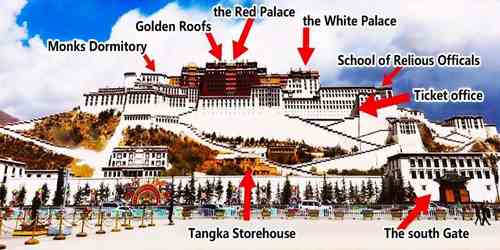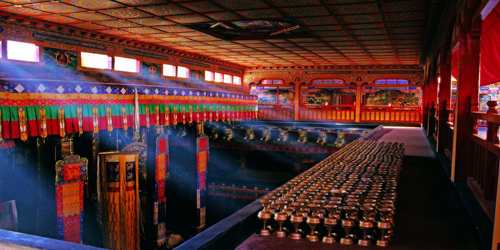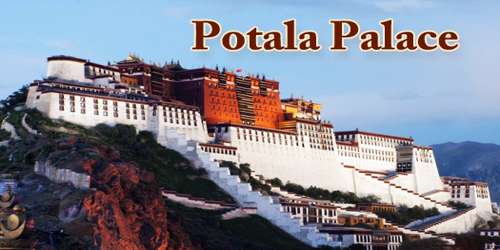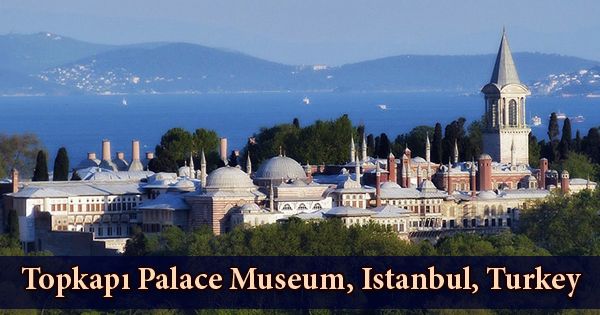The Potala Palace is a dzong fortress, immense religious and administrative complex in Lhasa, southern Tibet Autonomous Region, southwestern China. It was the winter palace of the Dalai Lamas from 1649 to 1959, has been a museum since then, and is a World Heritage Site since 1994.
It is situated atop Mar-po-ri (Red Mountain), 425 feet (130 metres) above the Lhasa River valley, and rises up dramatically from its rocky base. Potrang Karpo (completed 1648; White Palace) once served as the seat of the Tibetan government and the main residence of the Dalai Lama; from the mid-18th century it was used as a winter palace. Potrang Marpo (1694; Red Palace) houses several chapels, sacred statues, and the tombs of eight Dalai Lamas; it remains a major pilgrimage site for Tibetan Buddhists.

Regarded as landmark and the symbol of Tibet, it is a great giant palace consisting of many houses, towers, chapels, etc. According to the Guinness Book of World Records, Potala Palace is the highest palace in the world. Because of its spectacular architecture style, it is honored as one of the most beautiful architectural building in the world.
The palace is named after Mount Potalaka, the mythical abode of the bodhisattva Avalokiteśvara. The 5th Dalai Lama started its construction in 1645 after one of his spiritual advisers, Konchog Chophel (died 1646), pointed out that the site was ideal as a seat of government, situated as it is between Drepung and Sera monasteries and the old city of Lhasa. It may overlay the remains of an earlier fortress called the White or Red Palace on the site, built by Songtsen Gampo in 637.
Located in the northern of Lhasa, adjacent to Jokhang Temple with 1.6 km and 1.5 km away from Barkhor Street, Potala Palace is mostly chosen for the first attraction of your Tibet Travel, and you can easily to get there from the airport or train station in Lhasa.
- 70 km away from Lhasa Gonggar Airport
- 20 km away from Lhasa Railway Station
By connecting many domestic cities, including Chamdo, Beijing, Shanghai, Chengdu, Chongqing, Xian, Guangzhou and more, taking flight to Lhasa Gonggar Airport is the first choice to arrive in Lhasa. With a distance of 70 km from airport to Potala Palace, you can take the airport shuttle bus within one hour. Besides the airline, you can take the Qinghai-Lhasa Railway to the Lhasa Railway Station and take taxi to the Palace. If you book Tibet tour with us, we can arrange the private transfer service and pick you up at the airport or train station.
The building measures 400 metres (1,300 ft) east-west and 350 metres (1,150 ft) north-south, with sloping stone walls averaging 3 metres (9.8 ft) thick, and 5 metres (16 ft) thick at the base, and with copper poured into the foundations to help proof it against earthquakes. Thirteen storeys of buildings, containing over 1,000 rooms, 10,000 shrines and about 200,000 statues, soar 117 metres (384 ft) on top of Marpo Ri, the “Red Hill”, rising more than 300 metres (980 ft) in total above the valley floor.
Tradition has it that the three main hills of Lhasa represent the “Three Protectors of Tibet”. Chokpori, just to the south of the Potala, is the soul-mountain (Wylie: bla ri) of Vajrapani, Pongwari that of Manjusri, and Marpori, the hill on which the Potala stands, represents Avalokiteśvara.
Of more than 1,000 rooms in the Potala, the ones considered most holy are the Chogyal Drubphuk and the Phakpa Lhakhang, remnants from the original palace of Srong-brtsan-sgam-po; the latter houses the sacred Arya Lokeshvara (Avalokiteshvara) statue. More than 200,000 statues and 10,000 altars are located within the sacred complex. Its value was recognized by China’s Cultural Relics Commission, and the palace was spared during the Cultural Revolution. The Potala was designated a UNESCO World Heritage site in 1994. Two other locations Tsuglagkhang, or Gtsug-lag-khang (Jokhang), Temple, one of the holiest places in Tibetan Buddhism, and the Norbuglingka (Nor-bu-gling-ka; Jewel Palace), the former summer residence of the Dalai Lama were added to the World Heritage site in 2000 and 2001, respectively.
The Historic Ensemble of the Potala Palace, Jokhang Temple and Norbulingka embody the administrative, religious and symbolic functions of the Tibetan theocratic government through their location, layout and architecture. The beauty and originality of the architecture of these three sites, their rich ornamentation and harmonious integration in a striking landscape, contribute to their Outstanding Universal Value.
Potala Palace’s history can be traced back to about 1,300 years ago since which Potala has been through several large reconstructions. It was originally built in the 7th century when the Tubo Kingdom ruled Tibet to house Srongtsen Gampo and his two wives – Princess Bhrikuti of Nepal and Princess Wencheng of Tang Empire.
After the fall of Tubo Kingdom, Potala Palace was almost ruined by constant wars until 17th century when came the most important reconstruction during Potala’s history. His Holiness the Fifth Dalai Lama decided to rebuild Potala Palace. He received helpful hands from Qing Empire. The constructions took almost many years.
At last, the Fifth Dalai Lama moved the government from Drepung Monastery to Potala, which made Potala as the political and Buddhism center of Tibet. Since the Fifth Dalai Lama, several small reconstructions had been conducted by the later Dalai Lamas. The main body of Potala Palace has remained as the same as the past.

The Chinese government responded by enacting a rule barring the building of any structure taller than 21 metres in the area. UNESCO was also concerned over the materials used during the restoration of the palace, which commenced in 2002 at a cost of RMB180 million (US$22.5 million), although the palace’s director, Qiangba Gesang, has clarified that only traditional materials and craftsmanship were used. The palace has also received restoration works between 1989 and 1994, costing RMB55 million (US$6.875 million).
The number of visitors to the palace was restricted to 1,600 a day, with opening hours reduced to six hours daily to avoid over-crowding from 1st May 2003. The palace was receiving an average of 1,500 a day prior to the introduction of the quota, sometimes peaking to over 5,000 in one day. Visits to the structure’s roof were banned after restoration efforts were completed in 2006 to avoid further structural damage. Visitorship quotas were raised to 2,300 daily to accommodate a 30% increase in visitorship since the opening of the Qingzang railway into Lhasa on 1 July 2006, but the quota is often reached by mid-morning. Opening hours were extended during the peak period in the months of July to September, where over 6,000 visitors would descend on the site.
The Historic Ensemble of the Potala Palace owns tens of thousands of collections of diverse cultural relics. The wall paintings are rich in themes, form the best of Tibetan painting art and precious material evidence for learning Tibetan history and the multi-ethnic cultural fusion. The historic scale, architectural typology and the historic environment remain intact within the property area and within the buffer zone, carrying the complete historic information of the property.
In terms of design, material, technology and layout, the historic ensemble of the Potala Palace has well retained its original form and characteristics since it was first built and from successive significant additions and expansions, convincingly testifying to its Outstanding Universal Value.
Potala Palace is one of the most brilliant architectural buildings standing on the precipitous hill. Having a majestic exterior of 13 layers in the total height of 117 meters, the whole palace was built by wood and stones. The walls were piled by granite with a thickness of 2-5 meters. The roof and eaves are made of woods with beautiful carvings about Buddhism. Constructed by the white and red palaces, there are ornate chapels, halls, rooms inside. The palace can be divided to two main parts: the White Palace around and the Red Palace in the center. The White Palace was the living quarters of the Dalai Lama and the office to deal with political and Buddhist affairs. And the Red Palace is the main building for 117 meters, consisting of a complicated layout of different Buddhist halls, chapels and libraries.
The lower white frontage on the south side of the palace was used to hoist two gigantic thangkas joined together representing the figures of Tara and Sakyamuni during the Sertreng Festival on the 30th day of the second Tibetan month.
The Chinese Putuo Zongcheng Temple, also a UNESCO World Heritage Site, built between 1767 and 1771, was in part modelled after the Potala Palace. The palace was named by the American television show Good Morning America and newspaper USA Today as one of the “New Seven Wonders”.
The nine storey Leh Palace in Leh, Ladakh, India built by King Sengge Namgyal (c. 1570-1642), was a precursor of the Potala Palace.
Usually, it is available to visit Potala Palace in all seasons because Lhasa is usually mild all the year around without cold winter or hot summer. But if you want to extend your Lhasa tour to other areas, like Namtso or Everestk May to October is the best time. Take an overcoat even in summer days while visit Potala Palace, as it is a bit cold and damp in the Palace.
Information Sources:
















